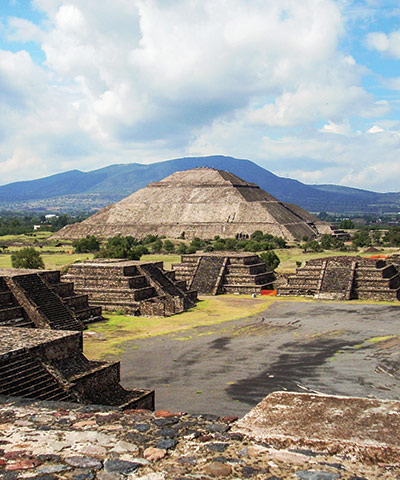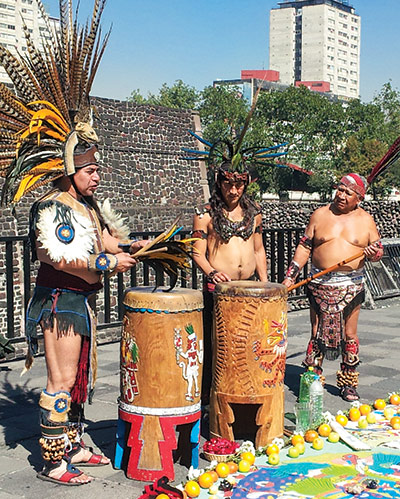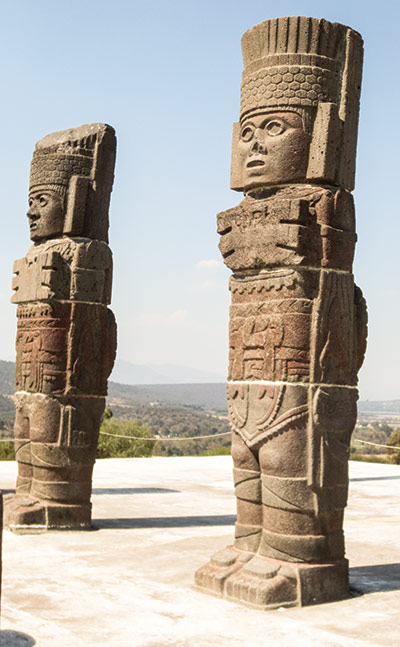
The renewed interest in Toltec wisdom is less of a trend and more of a strengthening heartbeat. Anchored in ancient Mexica civilization, these teachings were long a mystery to all but a few, but now are re-emerging with devotees as diverse as a Canadian nurse, British publisher, American advertising executive, and Finnish teacher.
In February, a group from nine countries and 27 cities gathered in Mexico City for a ten-day intensive course on the ancient traditions and archeological centers of the Toltec empire entitled, “Flowering of the Sixth Sun: The Quest for Quetzalcoatl.” The intimidating agenda included classes like Mexica Cosmology; Life, Death and Dreaming; Becoming Gods; and Flowering as Quetzalcoatl.
What can those of us in the 21st century learn from people who lived in Mexico between the 10th and 12th centuries? More than you might think.
On the first day, students were given their “birth codex,” revealing their special gifts and “shadow aspects” through a process that included complex cosmology, sacred mathematics and information revealed in the Aztec calendar. In late afternoon, they gathered at the Zocalo, the vast plaza in downtown Mexico City, to perform a dance ritual led by Toltec elder Xolotl Martinez and his “spiritual warriors.” Students joined in dances, concluding with the planting of a new destiny, and nurturing special gifts, symbolized with corn seeds laid at an altar in the center of the dance circle. Speaking in Nahuatl, the ancient Toltec language, Martinez advised: “Stay present throughout the evening. Stay present in everything you do.”
The ruins of Cholula, with the largest pyramid in the world, provided the classroom for a day of “dying consciously.” Sergio Magaña, author and founder of the Centro Energetico Integral, began with stories of rituals performed by the women of Cholula in the Temple of the Dead, preparing through lucid dreaming to reach their greatest destiny in death and what follows. Unlike Don Miguel Ruiz, best-selling author of the mass-market The Four Agreements, Magaña tells students there are no short-cuts, no days off. “You must do the work. Every day. Only with extreme dedication and commitment can you reach your highest destiny.” Students were invited to let die aspects of themselves that didn’t serve them to “make space for what you want to become.” With a disciplined deep breathing exercise, and advanced visualization, each student transformed into a butterfly, flying into the sun with past pains and problems and returning each time with characteristics of the person they were to become.
At Tula, the ancient Toltec capital, lessons of lucid dreaming, one of the core tenets of Toltec wisdom, continued with Hugo Nuhui. At Tula can be found four huge stone figures, believed to represent the four Tezcatlipocas, good, bad and evolving aspects of self. In a rare point of practicality, Nuhui instructed students to plant dreams with a plan. Through an interpreter he said, “If you dream of riches and abundance, plant dreams of the job you are going to get, the hard work you are going to do, the success you are going to have because of the time and talents you invest.”
Teotihuacan, the largest and most impressive ruins in Mexico, literally translates in Nahuatl as the “place where men and women become gods.” At each of the main pyramids — those of the Sun, Moon and Quezalcoatl, Magaña lead the group rituals of manifestation. Breathing in counts of four, nine or 13, based on “ancient cosmic cycles,” Magaña encouraged devotees to release old winds and destructive patterns, to pull out suffering and become the best possibility of self.
“You get what you create in your thoughts, actions and dreams,” he whispered as he sent students into an energetic bliss. Symbolism abounded as he urged: “Become a serpent and heal your past. Or a crocodile to create abundance. Hummingbirds have great willpower. Dogs are good with family.” At the final and most beautiful stop, the Temple of Quetzalcoatl, students were encouraged to absorb the energy of the temple and “invite the rising serpent in, giving rise to enlightenment, kindness, power and wisdom.” Each exercise ended with the Toltec mantra of Ometeotl.
“Each of the ancient pyramids has a different energy. The knowledge of these ancient people is profound. These are sacred sites,” said one participant, James Coldsnow, a San Francisco artist and three-year devotee of Toltec breath, dreaming and manifestation techniques. At the ruins of a temple known as the meeting point of wisdom keepers of various tribes, Coldsnow carefully placed several recent paintings to “infuse the work with the power, energy and blessings of those that have come before.”
Metaphors, myths, movement and manifestations converged in the final days as students were initiated into the Mexica Path. All-night singing, dancing, chanting celebration was shared with locals of Toltec lineage, adorned in traditional clothing and feathered headdresses. At sunrise, in a closing ceremony, each person received his or her Nahuatl name, “Bringing harmony with nature and highest possibility of self.”
Afterwards, there was much talk of “life changing,” and promises were made regarding sharing the wisdom and deeper exploration. Quickly bags were packed and planes departed to Europe, Canada and the United States. People came for healing, defying medical diagnosis and nurturing emotional disappointments. They came for direction on careers or relationships or new homes. At the end of the journey, they left with inspiration, and insights into living positive, progressive and fulfilled lives.
Will the ancient teachings of the gifted craftsmen, artists, architects and, of course, dreamers who were the Toltecs continue to spread? Time will tell, but one thing is certain. Their wisdom, thought to have been lost for centuries, is providing a tiny yet profound exchange between Mexico and the rest of the world.
Alicia Smith, an international consumer behavior specialist, is President of Perspectives. For information on Sergio Magaña’s work, upcoming book and Toltec course work, contact Valerie Niestrath at www.valerieniestrath.com.
By Alicia Smith


